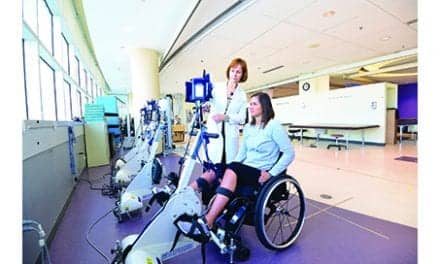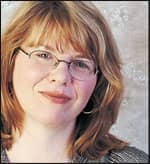Pushing, eating, reaching, and lifting are big, key movements for stroke survivors. To support the recovery of these movements a new robotic device called Myomo (my own motion) has been introduced, and is engineered to take advantage of electromyography (EMG)-based biofeedback as a way to restore vital functions that help stroke patients conduct the activities of daily living.
The control software within the Myomo device monitors and senses the affected muscles’ intent to move, but it does not stimulate the muscles to prompt movement. The initiation of movement lies with the patient. The system has the ability to detect weak EMG muscle signal and transmit data to the device’s motor. This transmission enables the patient’s desired motion.
Myomo’s technology was originally developed at Massachusetts Institute of Technology (MIT), Cambridge, Mass, in collaboration with medical experts affiliated with Boston, Mass-based Harvard Medical School. The personal robotic device encourages neurologically impaired patients to engage the affected limb in repetitive tasks and exercise. To bolster this process, the EMG-based robotics of Myomo require the patient to be actively engaged throughout the duration of the therapy session. Any halt in motion on the patient’s part, halts the device’s assistance.
.png)
Six sensors are applied to the patient’s affected limb prior to fitting the system’s sleeve to the patient: three for biceps and three for triceps. Myomo uses these sensory/motor receptors to sense partial or full movement. In turn, Myomo assists patients in completing the intended movement. The process is intended to enable the brain to rewire pathways to motor functions and re-learn movement.
Rose Ann Weinstein, MPT, physical therapist and founder of the Los Angeles, Calif-based Able Place, says there is a vital facet in every rehabilitation technique for which the Myomo is ideally suited; repetition, “In order to get these new pathways to form you have to do things over and over, it’s all about practice,” Weinstein says. “The device allows multiple repetitions; it allows the patient to do what has to be done and to get to where he has to go.”
Patient Powered Rehabilitation
The amount of assistance that the device provides can be adjusted. An electronic tablet is used alongside Myomo via the use of a Bluetooth. The electronic tablet allows patients to view how much power their triceps or biceps exert. The existing levels of exertion .jpg)
Stroke patient Sean Sornborger (pictured right) began exercise treatment with Myomo following his stroke a year and half ago. Sornborger’s left hemisphere was affected, impairing his ability to move his right side and his ability to speak. A number of rehabilitation techniques, including the Myomo therapy program, have enhanced Sornborger’s recovery.
Sornborger adds that he has made “a lot of progress eating, laying down, pushing out of bed, flexing, and bending my elbow…amazing stuff,” Sornborger says. He has gotten to the point where he can accomplish tasks with or without the device.
As Sornborger learns to control his biceps and triceps, Lee says, the device amplifies his progress by helping him move when his muscle misfires.
This self-initiated movement is how Myomo maintains its clinical effectiveness, which the device’s manufacturer reports can last more than 21 years. Adam Riley, Myomo Business Development, west coast region, describes the source of Myomo’s efficacy as, “brain power over muscle power.” The device is powered by the patient and the patient’s intent to be rehabilitated.
System Use and Considerations
Patients usually go to a certified Myomo therapist once a week. Patients can also rent the device for home-based therapy, paying $250 for a month trial. The device is $5,000 to buy. Through Medicare, patients can purchase it after the first month and finance it from that point on.
Myomo is marketed to end users and clinics. Northridge hospital, headquartered in Northridge, Calif, has the device on-site for patients’ use. The disadvantage to this setting, Lee points out, is that patients are not obtaining any repetition benefits.
Despite Myomo’s effectiveness, the device has several contraindications for which clinicians should be observant of, including the potential to shoulder dislocation among patients who cannot safely support the weight of their arms in addition to the 3-pound weight of the device. The Myomo website also recommends the discontinuation of the device if its torque does not match the patient’s desired motion, if the patient experiences shoulder pain correlated with the use of the device or frequent uncontrolled motion and unintentional movement, if rashes occur on the arm, and if persistent redness, swelling or skin breakdown in the region around the sensors or around the edge of the device. Myomo is also not recommended for patients with a recent history of muscle spasms or patients who are not cognitively engaged.
Recovery Through Repetition
Stroke survivor Lina Kurniawan has completed the Myomo therapy program. Kurniawan’s daughter, Nani, explains that like any therapy, the device is not magic and for a patient to simply follow the book of exercises provided with the device is not enough. “It’s just a tool, you need a trained therapist to guide you through the whole Myomo experience,” the younger Kurniawan explains.
That sentiment is echoed by Lee, “That’s why we like to partner our patients with therapists, so we don’t leave patients on their own," she emphasizes.
The certified therapist assigns patients a set of tasks to accomplish. If there is progress, new tasks are assigned. Assigned exercises include everyday tasks, such as picking up and releasing items, and folding laundry. “It goes in sync with daily life,” Nani Kurniawan says. Her mother is now able to move her affected shoulder normally.
“There is no magic way to do it except through repetitive exercise. It has to be through the individual that you see results.” Nani says.
For more information about Myomo or Able Place, visit www.myomo.com and www.able-place.com
Source: Brittan West, Associate Editor

.png)



